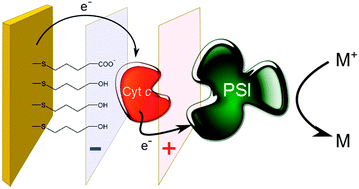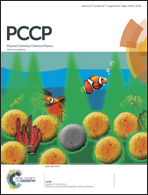Advanced unidirectional photocurrent generation via cytochrome c as reaction partner for directed assembly of photosystem I†
Abstract
Conversion of light into an electrical current based on biohybrid systems mimicking natural photosynthesis is becoming increasingly popular. Photosystem I (PSI) is particularly useful in such photo-bioelectrochemical devices. Herein, we report on a novel biomimetic approach for an effective assembly of photosystem I with the electron transfer carrier cytochrome c (cyt c), deposited on a thiol-modified gold-surface. Atomic force microscopy and surface plasmon resonance measurements have been used for characterization of the assembly process. Photoelectrochemical experiments demonstrate a cyt c mediated generation of an enhanced unidirectional cathodic photocurrent. Here, cyt c can act as a template for the assembly of an oriented and dense layer of PSI and as wiring agent to direct the electrons from the electrode towards the photosynthetic reaction center of PSI. Furthermore, three-dimensional protein architectures have been formed via the layer-by-layer deposition technique resulting in a successive increase in photocurrent densities. An intermittent cyt c layer is essential for an efficient connection of PSI layers with the electrode and for an improvement of photocurrent densities.


 Please wait while we load your content...
Please wait while we load your content...